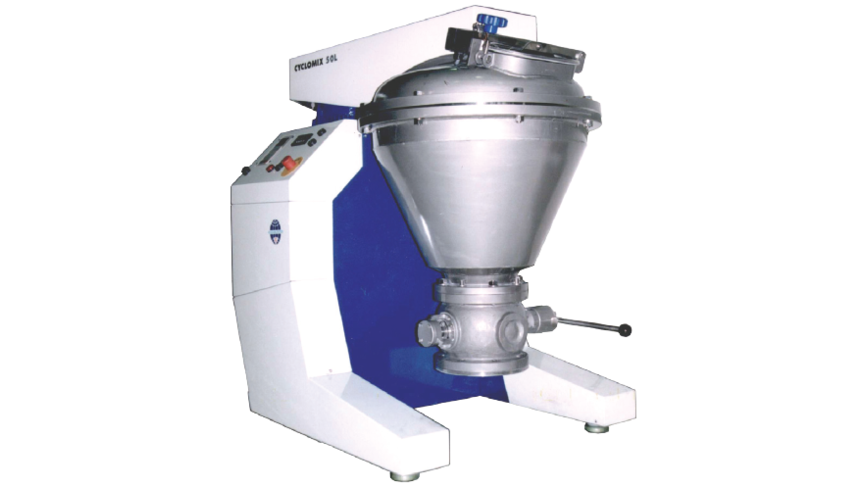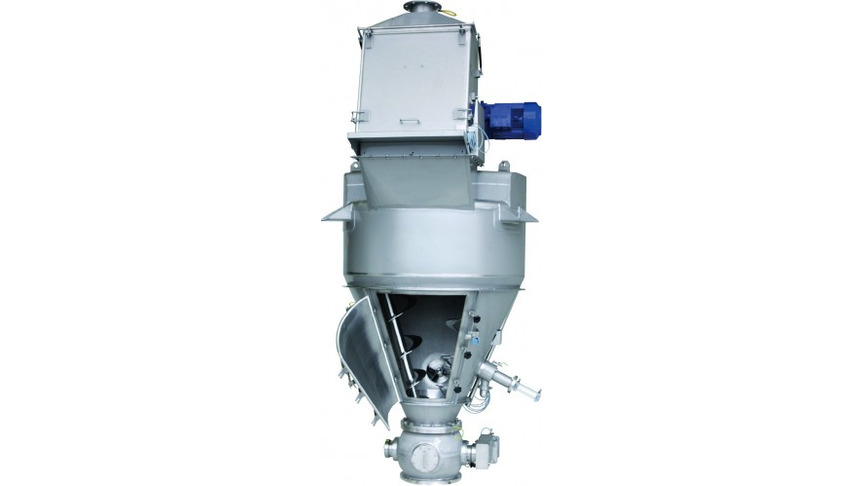- Industries & Machines Industries & Machines
- IIoT IIoT
- Service-Toll Processing Service-Toll Processing
- Material Material
- News News
- IR Information IR Information
-
Sustainability
Sustainability
Sustainability
- Introduction
- Hosokawa Micron Group "Basic Human Rights Policy"
- Sustaibality Policy - Mission Statement
- Editorial Policy
- Integrated Report
- Materiality & Strategy
- Technological contribution to a sustainable global environment
- Contributions towards a safer, more secure and prosperous society
- Sophistication of governance that supports business
- ESG Data Collection
- Sustainable Business Management ~ Finance
- Infromation Disclosure Based on TCFD Recommendations
- Jobs and Careers Jobs and Careers
-
About Us
About Us
About Us
- Greetings (Company Introduction)
- Hosokawa Micron Group "Basic Human Rights Policy"
- Management Philosophy
- Corporate Overview
- Corporate Profile
- Business Areas and Strengths
- Corporate History
- Hosokawa Micron Group
- Domestic Facilities
- Overseas Subsidiaries (Asia)
- Overseas Subsidiaries (Europe)
- Overseas Subsidiaries (America)
- Asian Agents
- Powder Technology Research Institute
- Industrial Property Rights
- Journals and Books
- Technical Information
- Annual Publication "Micromeritics"
- Compliance Charter
- Privacy Policy
- Cookie Policy
- Quality Principle

Industries & Machines
- TOP
- Industries & Machines
- Machines Search
- VRIECO NAUTA MIXER Series
VRIECO NAUTA MIXER Series
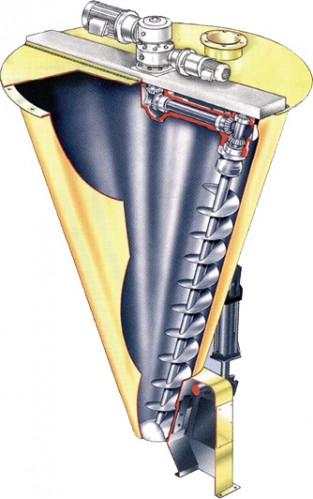
Summary
The Vrieco Nauta Mixer is a widely used powder mixer with over twenty thousand units delivered worldwide. It consists of a conical body with a mixing screw attached to a rotating arm. The Vrieco Nauta Mixer has several favorable attributes such as mixing swiftly with low energy consumption, minimal damage to the powder particles, ease of discharge with low amount of residue, and ease of cleaning making use for multiple products easier. Because of these characteristics, the Vrieco Nauta Mixer is used for the mixing of powders, mixing of powders with liquids, and also as heater, dryer, reactor and cooler. With a wide range of models and options, the Vrieco Nauta Mixer can meet a wide variety of requirements and applications.
(NAUTA & "NAUTA MIXER" is a registered trademark of HOSOKAWA MICRON CORPORATION in Japan)
Principle
The Vrieco Nauta Mixer consists of a conical vessel with drive(s) at the top. The drive rotates a swing arm that rotates around the centerline of the mixer. At the tip of the swing arm is a mixing screw that rotates. The rotation of the swing arm moves the rotating mixing screw along the inner surface of the conical vessel.

Fig.1 Vrieco Nauta mixer
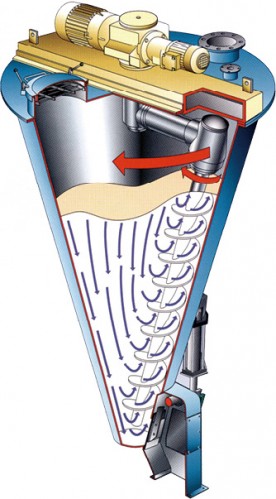
Fig.2 Schematic structure of Vrieco Nauta mixer
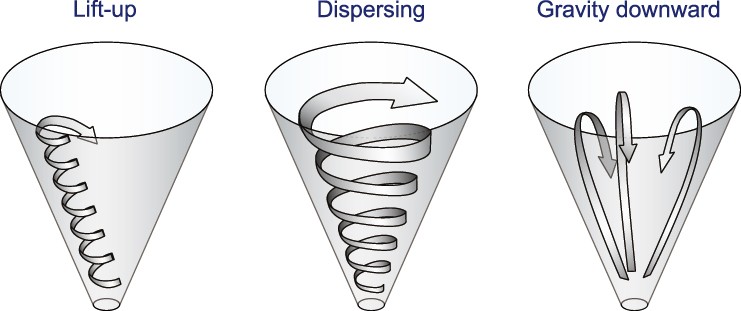
Fig.3 Basic principal of mixing by Vrieco Nauta mixer.
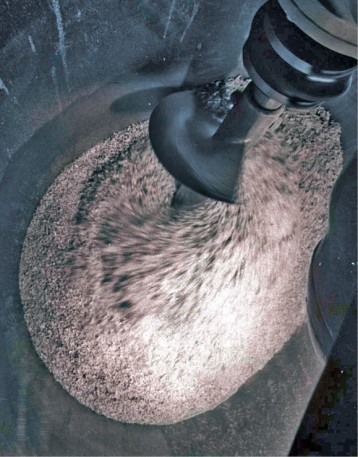
Fig.4 Operating situation
Fig.2 shows the mixing model of a Vrieco Nauta Mixer. The rotating mixing screw lifts the material around the screw up while material away from the screw moves down due to gravity. The slow movement of swing arm moves the rotating screw along the inner wall of the vessel eventually moving all of the powder in the mixer. The movement of the powder is very gentle but almost no segregation occurs allowing for efficient and swift mixing to occur. Since all of the powder in the mixer is not moved at the same time, the power requirements are very small.
After 1'50", you can show that how two powders are quickly mixed.
Features
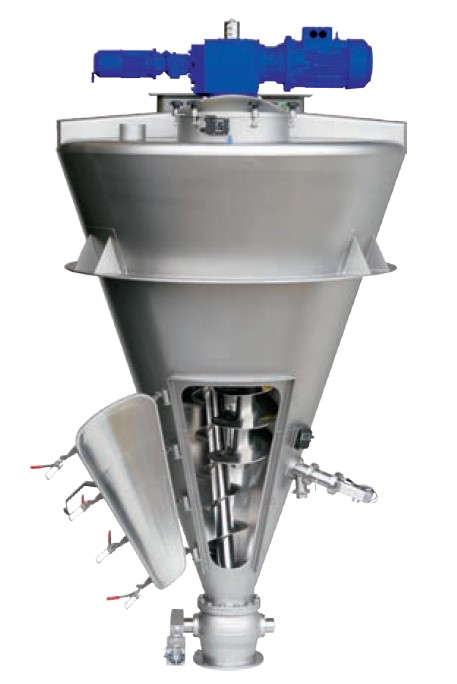
Fig.5 Big Access Door (Option)
Swift mixing with minimal energy consumption
Due to the efficient mixing principle, swift mixing is achieved with low energy consumption. For simple mixing of powders, 300 liters can be mixed in 3 to 10 minutes. For 3000 liters, mixing is completed in 15 to 45 minutes.
Mixing deviation converges quickly with little variation
Generally mixers have a large convergence and divergence of mixing levels depending upon the mixing time with material separating after mixing. In the Vrieco Nauta Mixer, this separation does not occur.
Minimal damage to particles
The shear force on the particles is very small resulting in minimal damage to the particles.
Low heat generation
The low energy consumption results in low heat generation. Mixing of materials with a low softening point of 50°C is possible.
Easy to discharge material with little residue
The conical shape with the discharge port at the bottom makes discharge of material easy with a minimum of residue.
Large machines possible
With the vessel fixed and with a small screw diameter, the required power consumption is small allowing for design of large machines.
Low vibration
When operating, the Vrieco Nauta Mixer has almost no vibration allowing for high accuracy weight measurements. Also there is no need to consider vibration for the supporting structure.
Easy to clean
The Vrieco Nauta Mixer is a simple machine with one or two screws inside a vessel allowing for easy cleaning.This makes changing products easier and maintenance is also simplified.
The big access door on the side of the vessel allows for full access to the interior for cleaning. (Option)
No seals within the material bed
By having the drives at the top of the machine, there is no need for seals to be inside the material bed. This prevents seal damage due to wear from powder contact.
Simplifying processes
It can be used for mixing, drying, reaction, cooling.
Table 1 Comparison with other types of mixer
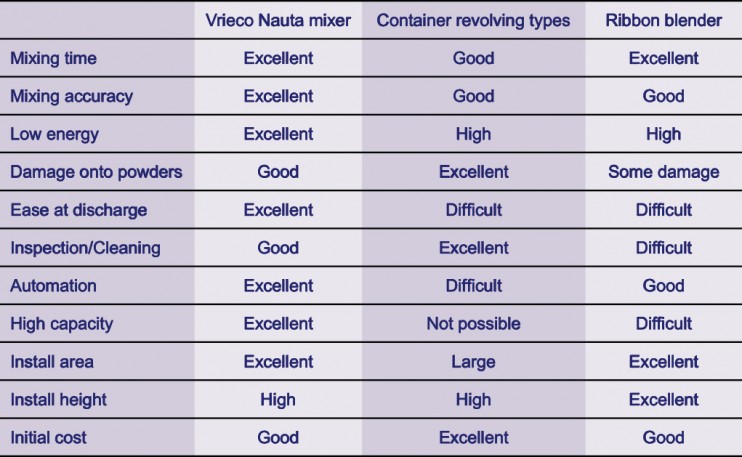
Models
There are two basic types of Vrieco Nauta Mixer, one with a cantilevered mixing screw and another with a bottom supportedscrew. There are 2 types of bottom support, a radial locator type and a pin joint type.
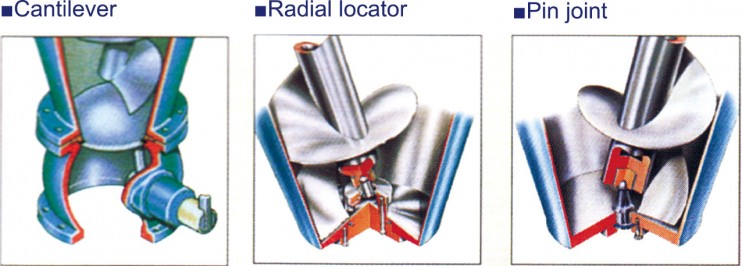
Fig.6 Bottom supporting mechanisms
The Mixing Process
Mixing is a process where two or more materials are mixed together. There are many methods to express the level of mixing and there are also many evaluation methods. The amount of effort required to measure samples in a statistically relevant way is unrealistic.
The required level of mixing differs between if the mixed material is a raw material, intermediate material or a final product. Another important factor is the unit volume of mixed material used in the product. It is better if the analysis method is based upon the quality control method in use.
For scale-up, the mixing time and energy consumption becomes an issue. The power consumption increases proportional to the weight of the material to be mixed. For materials with a high bulk density or for materials with a big difference between the bulk and tapped densities, care must be taken. Mixing time depends upon the material average circulation time, but factors such as past performance and experience must be taken into account.
Care must be taken handling the mixed product to prevent the mixed particles from segregating. When designing a mixing system, all of these factors must be taken into account.
NAUTA MIXER DBX Type
The DBX is a Vrieco Nauta Mixer with a cantilever mixing screw throughout the product range. By not having a bottom support, mixing of materials with low temperature resistance, abrasive materials, friable materials are possible. Also suitable for applications where cleanability is important such as when there are frequent product changes.

Fig.7 DBX Type
DBX Type features
- Cantilever mixing screw design throughout the model range increasing cleanability
- Drive unit uses direct drive motors increasing safety and maintainability
- Gear losses are reduced to reduce energy consumption
- Vacuum type DBX-RWV can be used for drying and reaction processes (refer to dryer section)
NAUTA MIXER VN Type
The new standard model developed with ease of use and cleaning as a primary requirement, with cost reduction using standardized parts.
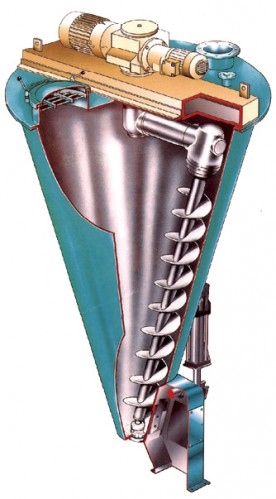
Fig.8 VN Type
VN Type features
- Newly designed shaft seals prevent lubricant from leaking into the product.
- Minimized the number of fasteners in the machine interior. Bridge cover is also a box construction greatly increasing clean ability.
- Compact design gearbox and swing arm reducing height
- Sanitary design with safe seals on the drive assembly
- Reduction of gear losses reducing energy consumption
- Many options available
NAUTA MIXER NX Type
Original Vrieco Nauta Mixer series covering wide range of mixing volume. As options, twin screws type NXW and double spiral screw type NXR are available. For vacuum drying purpose, NXV type should be proposed.
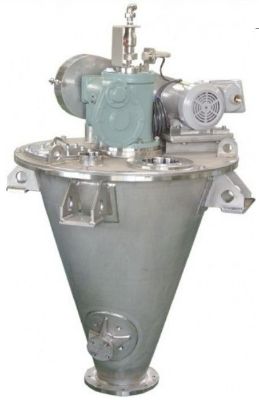
Fig.9 NX Type
NX Type features
- NX type is the standard model of the Vrieco Nauta Mixer. For volumes below 300 liters, the mixing screw is cantilevered. For volumes above 600 liters, the standard bottom support is the pin joint. Compressed air injection is available as an option.
- NXW type has 2 mixing screws and a flat bottom. The flat bottom reduced the total height compared to a NX type with the same volume. The twin mixing screws reduce mixing time to half of that of an NX type.
- NXR type has a faster mixing screw tip speed compared to the NX type. Used for mixing powders with liquids where a higher shear is required or for mixing pastes or materials with a large difference in specific gravity.
NAUTA MIXER CX Type
The CX type is the model combining 2 sets of NX type into a single mixer. In addition the mixing effect of the standard NX type, material also flows between the 2 sections prompting further mixing. The total height of the mixer is less than the equivalent volume NX mixer, and the mixing time and discharge time is less. The load on the mixing screw is distributed to the 2 screws increasing stability in operation.

Fig.10 CX Type
CX Type features
- The installed height of the mixer is less than that of an equivalent volume NX model
- The mixing time is half that of an equivalent volume NX model
- In cases where scale-up is limited by the required power, scale up to 2 times that of an NX model is possible.
NAUTA MIXER DBY Type / LV
Laboratory model uses the same Vrieco Nauta Mixer mixing principle. The mixing screw and mixing container can be removed easily. The container can be used to hold product. A case to prevent dispersion of powder is provided.
DBY Type / LV features
- Mixing time is very short with good mixing even with very big mixing ratios
- Very small deviations even after mixing is completed
- Small and light allowing for easy movement
- Screw speed can be adjusted as needed between 100 - 200 rpm
- Maintenance free bearings require no lubrication
- Simple design making for easy cleaning and disassembly
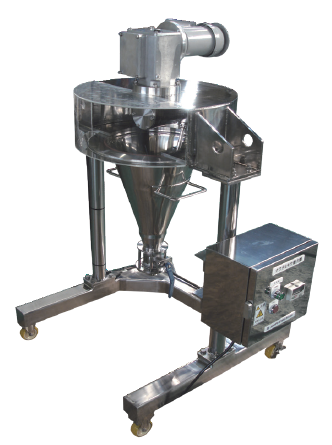
Fig.11 DBY Type
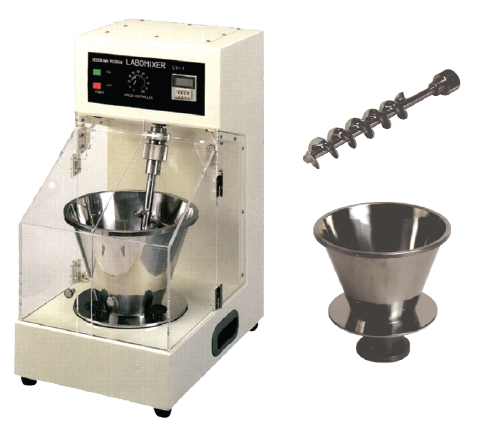
Fig.12 LV (2.5 L)
Options
Intensifier
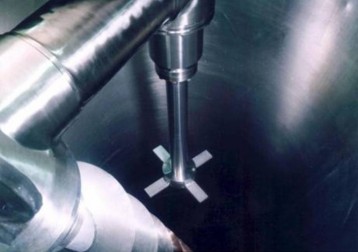
Fig.13 Intensifier
The Intensifier is a high speed-mixing rotor installed in the center shaft. It prevents agglomeration and prevents light materials from segregating on the top of the material bed when mixing materials with large differences in density. It can also be used to increase dispersion effects when adding liquids. The rotating mixing screw continuously brings material to the Intensifier allowing for efficient mixing to occur.
Vacuum sanitary dome cover
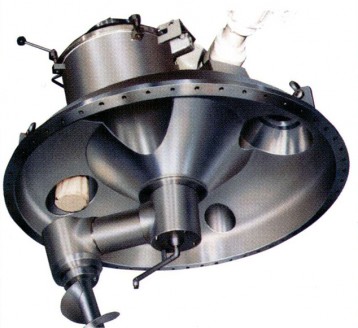
Fig.14 Sanitary dome cover
Used when the mixer is used in a negative or positive pressure. The drive and arm are also designed for negative or positive pressure. The domed cover is also used when ease of cleaning is a requirement.
Microjet
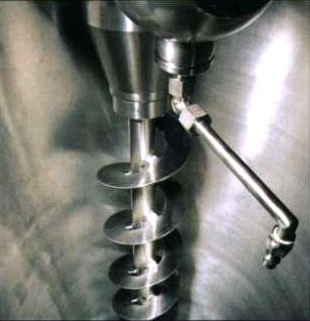
Fig.15 Microjet
A device used to inject liquid into powder bed. A pipe is installed in the center shaft through the drive section to a single or multiple nozzles installed on the arm.
At the inlet of the Microjet device, a rotary joint is installed where liquid is supplied by a pump or with pressurized air of around 1 to 5 MPa. The liquid is sprayed on to the powder bed from the nozzles as a mist. The spray is aimed at the top of the powder bed where the mixing screw rotates around the vessel leading to a very good mixing of liquid and powder. Using dual fluid nozzles gives better dispersion of the liquid.
Lump Breaker
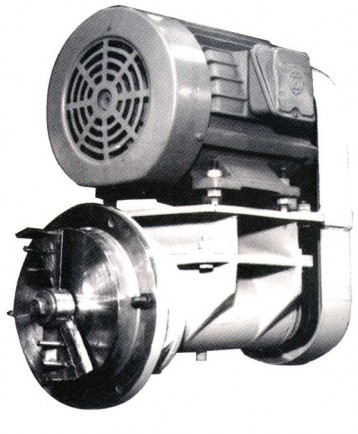
Fig.16 Lump breaker
When material has agglomerates during mixing or when agglomerates are generated due to adding of liquids, using a Lump Breaker breaks up the agglomerates to enable good mixing results. The Lump Breaker is not suited to reducing the particle sizes of the mixed materials, breaking up of hard agglomerates or for use with heat sensitive materials.
Level Control
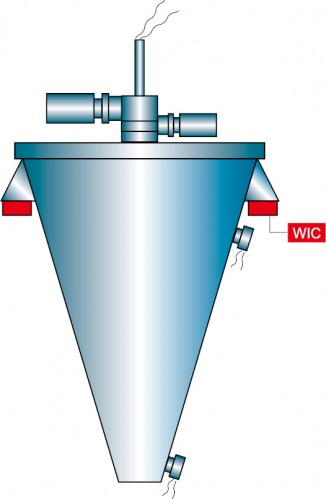
Fig.17 Level control
Since the Vrieco Nauta Mixer has almost no vibration during operation, it is possible to install loadcells on the support brackets. Measuring the weight of the material fed into the machine or discharged from the machine can easily be done. The deviation of the measured weight due to vibration or balance deviations is ±1 kgs. If measured with the Vrieco Nauta Mixer stopped, the accuracy is the same as a simple weighing hopper. Level control using standard level sensor is also available.
Heating, Cooling and Drying
Fitting a jacket on the conical section allows the Vrieco Nauta Mixer to be used for heating, cooling, drying, or reaction of powders. For use as a vacuum dryer or reactor, vacuum/reactor type models are available.
Temperature Measurement
Installing a temperature probe through the gearbox like the Microjet piping is possible allowing the measurement of material temperature during operation.
Installation of temperature probes in the vessel is also possible.
Discharge
The standard discharge types are flap valve or slide gate. Both manual and automatic pneumatically actuated types are available. Discharge through a ball valve at the bottom of the Vrieco Nauta Mixer or options such as adjustable positioners for the damper are available.
Related equipments

Feel free to contact us. if you have any questions or concerns.

